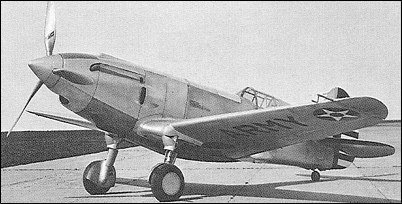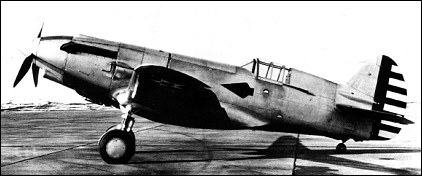|
| The 'long-nosed' P-37 was a Curtiss attempt in the late 1930s to couple the P-36 Mohawk design with the 992kW Allison V-1710-21 inline engine. The result was a pursuit ship with some promise but with a few serious drawbacks, including poor visibility from its far-aft enclosed cockpit. The sole XP-37, ordered in 1937 with a supercharged V-1710-11 powerplant, was nothing more than a P-36 airframe with the engine change. It was quickly apparent that the pilot not only could not see well in flight but also on the ground he could scarcely see at all! It was hoped that some improvement would be offered by the 13 service-test YP-37 airframes which were 0.56m longer and had the V-1710-21 engine.
The YP-37 aircraft went through rigorous tests at Wright Field, Ohio, including gunnery tests, but the visibility problem was not resolved and the YP-37s were not as stable as Army pilots wanted. Serious consideration was given to further development, but at the time Curtiss was also about to come forth with the P-40 which offered an inline powerplant without the drawbacks. Though they contributed to knowledge gained by fighter designers and tacticians, the YP-37s never reached operational service as other types appeared with greater promise. As world conflict loomed, multi-role missions were now being foreseen for aircraft once intended solely to chase other aircraft, and machines capable of a range of combat functions would increasingly become known not as pursuit ships but as fighters.
 | A three-view drawing of YP-37 (1278 x 944) |
| WEIGHTS |
| Take-off weight | 3255 kg | 7176 lb |
| Empty weight | 2596 kg | 5723 lb |
| DIMENSIONS |
| Wingspan | 11.38 m | 37 ft 4 in |
| Length | 10 m | 33 ft 10 in |
| Height | 2.90 m | 10 ft 6 in |
| Wing area | 21.92 m2 | 235.94 sq ft |
| PERFORMANCE |
| Max. speed | 547 km/h | 340 mph |
| Ceiling | 10360 m | 34000 ft |
| Range | 1400 km | 870 miles |
| ARMAMENT | 1 x 7.62mm + 1 x 12.7mm machine-guns |
| Vacfan, e-mail, 27.04.2016 03:03 Rarebits (Rareplanes) did a nice 1 /72 fuselage conversion for this which is pretty easy to do using a compatible P-36 kit. reply |
| vincent fiore, e-mail, 27.01.2016 21:51 A kit of Resin in 1 /72 scale in make by kora in the Ceck Republic. It can be had from them. Google Kora models to get thair Web sight. reply | | Mike Becker, e-mail, 20.05.2014 23:52 I built one of these by modifying a Revell /Monogram P-40C in 1 /48th scale. I moved the cockpit aft. Gave it side-mounted radiator intakes and cut in the intercooler vents and made new exhaust stacks. Used a turbocharger from a P-38 and the canopy from a P-51B. It won a model building contest and, after more than 30 years, it's one of my favorite models. reply | | Mike Becker, e-mail, 20.05.2014 23:51 I built one of these by modifying a Revell /Monogram P-40C in 1 /48th scale. I moved the cockpit aft. Gave it side-mounted radiator intakes and cut in the intercooler vents and made new exhaust stacks. Used a turbocharger from a P-38 and the canopy from a P-51B. It won a model building contest and, after more than 30 years, it's one of my favorite models. reply | |
| | a. machia, e-mail, 25.08.2013 09:53 A plastic model kit is available, imported by Joe's Hobbies in NJ. 1 /48th scale. reply | | timothydkey, e-mail, 17.04.2013 22:27 I found a copy of the comet plan for the XP-37 on this site (the outerzone) it is a free plan service. the plan doesn't have the formers, so it is incomplete, but it might give us something to work off of. Tim reply | | timothydkey, e-mail, 11.04.2013 20:52 I know joe ott, made a kit of the XP-37 with a 22inch wingspan, but i can't find a copy of the plans any where. reply | | timothydkey, e-mail, 07.03.2013 18:51 i am looking for balsa model plans for this beautiful aircraft reply | | Seth McKee, e-mail, 27.02.2013 02:05 In late summer 1939 I was assigned to the newly activated 23rd composite group at Maxwell field, Alabama, which was designated to be the operational test group for all Army air Corps aircraft and their weapon systems. During the late fall of 1939 I flew several missions in the P 37 to determine its suitability and its gunnery capabilities. The gunnery tests were conducted at what is now Eglin Air Force Base, and over the Gulf of Mexico. The test group activated Eglin on one July 1941. reply | | G L HALL, e-mail, 05.04.2012 23:44 A P-37 WAS DELIVERED TO CHANUTE FIELD IN THE SUMMER OF 1940, FROM WRICHT /PAT. I WAS AN INSTRUCTER IN THE ENGINE BRANCH AND THE ONLY TURBO CHARGERS WE HAD WERE ON P30 /PB2. THE P-37 DID NOT HAVE A TURBO ON IT. I HAVE NEVER HEARD OF TWO MECH UNITS DO YOU MEAN 2 SPEED? reply | | Klaatu83, e-mail, 06.03.2012 23:07 Essentially, The P-37 was a development of the P-36 (Hawk 75) fitted with an Allison engine equipped with an exhaust-driven turbo-supercharger in an effort to improve performance at higher altitudes. Because the supercharger was placed behind the engine, the pilot's cockpit had to be re-located further aft in order to maintain the airplane's balance. The result had a unacceptably detrimental effect on the pilot's view from the cockpit. In addition, the turbo-supercharger proved to be unreliable. Those were the principal reasons why the fighter was not accepted. The P-40, which had a less cumbersome gear-driven supercharger and a better pilot's view, was accepted for production instead. reply | | garrett o'melia, e-mail, 21.10.2011 16:06 s what we call a technology demonstrator. At one point, it was equipped with three superchargers: two mechanical and one turbo. They found, that the hubs for the Turbo, extended too much from the fuselage. That created too much drag and top speed was only 290mph with the Turbo. That's why the cockpit was so far back: too make room for all the superchargers. It was in fact:The first three stage supercharged aircraft. reply | | garrett o'melia, e-mail, 21.10.2011 16:05 s what we call a technology demonstrator. At one point, it was equipped with three superchargers: two mechanical and one turbo. They found, that the hubs for the Turbo, extended too much from the fuselage. That created too much drag and top speed was only 290mph with the Turbo. That's why the cockpit was so far back: too make room for all the superchargers. It was in fact:The first three stage supercharged aircraft. reply | | Evan Roberts, e-mail, 28.12.2010 17:57 Good to hear from you.I built this model in about 1938 or 39 as my second stick model.It was a smaller 18 to 20 inch version.Yes,please send me a copy of the plans, folded is good. Many thanks. Evan reply | |
| | Sergio Gonzalez, e-mail, 06.06.2010 13:14 I love this aircraft! It was Pinnacle to the war!!!!! reply | | Dave Seale, e-mail, 10.04.2010 18:04 SIG 4-Star 40, 60 or 120 can be kit bashed to create an XP-37. e-mail for more info reply | | Ron Sandberg, e-mail, 02.04.2009 20:06 What happened to the P-37 model that AM Tech was going to bring out.Wish some one would pick up on it!!!!! reply | | Ray McDonald, e-mail, 18.03.2009 01:14 stearman 995--If you mean a model kit, I built one from a kit in the late 1930's. I believe it was a Comet marque.
I saved my plans for a long time but they got thrown out while I was in the US Army. reply | | Evan Roberts, e-mail, 27.09.2008 21:11 Was this airplane ever kitted? If so,area kit or plans available? Thank you. reply | | Stan Keller, e-mail, 01.07.2008 04:48 Originally the P-37, P-38 and P-39 were to be turbo supercharged. The space required for the turbo and intercooler
resulted in the aft cockpit placement configuration of the P
-37
The XP-37 differed slightly from the YP-37, but both were turbo supercharged. reply |
|
Do you have any comments?
|
| 
COMPANY
PROFILE
All the World's Rotorcraft
|








 Vacfan
Vacfan
логотип дешево заказать
reply